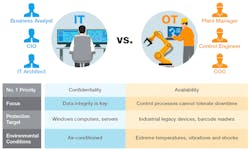Industries Are Transforming. What About Your Industrial Network Infrastructure?
Recent global events have made digitalization an urgent and compelling goal. Most companies, regardless of industry, are beginning to realize that digital transformation is imperative to avoid falling behind and becoming uncompetitive. We are seeing more and more industries speeding up innovation. Yet, many businesses are unable to successfully transform and futureproof their operations. One of the most common reasons is the misconception that digital transformation is just a matter of deploying new technologies or buying newer equipment.
Digital transformation is more than new technology
When only focusing on adding new technologies, companies will likely be unable to tap into their full potential despite the huge amounts of resources invested in the project. Achieving digital transformation for industrial applications not only involves introducing new technologies but also seamlessly integrating all the systems on the network. A smooth-running and fully integrated infrastructure is the foundation that enables newly added technologies to work in harmony with existing systems to enhance industrial operations.
Among industry leaders, IT/OT convergence has gained a lot of ground as the best-practice method to integrate new systems and create value. According to IDC’s IT/OT convergence survey1, more than 30% of organizations are planning to integrate operational data from systems such as data historian software, industrial control systems, and asset management into their enterprise data governance model for the first time.
When operational technology (OT) data is accessible to information technology (IT), it can be converted into a valuable asset and increase organizational agility. Therefore, seamless transmission of OT data between application endpoints, control centers, and corporate headquarters is essential for merging IT and OT systems and making sure newly added technologies work flawlessly. This explains why enhanced, robust industrial networks are an indispensable part of any successful digital transformation.
Industrial networks need to take a leap forward
The rapid growth of IT/OT converged applications has led to more diverse and real-time data as well as larger volumes of OT data. The complexity of industrial network infrastructure has also grown significantly. As a result, it becomes increasingly more difficult to maintain the network’s reliability, which determines the stability of machine-to-machine and machine-to-control center communications which, in turn, ensures continuous operations.
For the longest time, maintenance engineers were only concerned with whether the indicators on the network equipment were flashing green. Today, things are no longer that simple. As data is becoming the catalyst for future innovation, ensuring that data is delivered to the right place at the right time is critical. It’s the job of future-proof networks to make that possible.
Therefore, businesses should instead direct their attention to functional reliability. That is, to meet future needs, businesses should not only focus on stable network connectivity but also design their network to support seamless OT data connectivity.
To build an industrial network for the future, you need the help of an expert.
Transitioning industrial networks in this new direction is not easy and is unfamiliar territory for most OT engineers. Shifting towards a future industrial networking model comes with its own set of challenges and hurdles, including:
- The integration of OT and IT systems exposes traditionally isolated OT networks to outside threats. Cybersecurity attacks in the OT field have also soared in recent years.
- Expanding network connections has greatly increased the complexity of management. It’s impossible to rely on old tried-and-tested methods to manage hundreds and thousands of network devices efficiently.
- Successful digital transformation relies on the ability to ensure uninterrupted operations. Maintaining system reliability while implementing digitalization can be challenging.
- Industrial networks typically undergo minimal change from year to year. Considering long-term future usability when designing the network is important.
To help businesses overcome these hurdles and ensure a smooth transformation of their industrial networks, we offer some suggestions. We recommend choosing reliable hardware and software that can support the seamless data transmission and integration needs to sustain continuous operations. Additionally, dedicated OT network security is an essential building block that shouldn’t be overlooked in order to protect OT networks from cyber threats and maximize system availability.
Lastly, businesses should prioritize intuitive software to simplify management and reduce the workload on OT engineers. This allows for complex systems across the network to be more easily monitored and maintained. By combining the capabilities of network and data connectivity, businesses can incorporate intelligent functionality such as remote control commands and incident response mechanisms into their operations, and prepare for the needs of future OT applications.
With more than 35 years of industry experience and a deep understanding of OT networks, Moxa is committed to helping industrial networks take the leap toward the new generation of networking. Our futureproof networking solutions are designed to help businesses seamlessly merge their IT and OT systems and prepare them for transitioning to a digitalized future.
With an expert like Moxa, businesses can worry less about their industrial networks and focus on fully embracing digital transformation so they can leverage these digital innovations to boost performance and set themselves apart from the competition.











